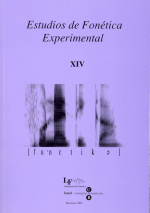Aproximación a la prosodia del habla de Madrid
Abstract
AMPER-Madrid is a research project that studies the main prosodic features of the geo-linguistic variety of Madrid Spanish focusing on its intonation structure and on the parameters of duration and intensity. The project aims at contributing to the multimedia map which intends to analyze and gather the main prosodic differences of the European Romance languages. The present study establishes a phonetic and phonological taxonomy of the characteristics prosodic features of Madrid speech. At this initial stage of the project we have focused on declarative and interrogative utterances without expansion which includes three different kinds of accents. Results are obtained following the rigorous and automatic methodology proposed by AMPER. The utterances have been digitized with Goldwave and the acoustic data have been analyzed with Matlab. The tonal structure has been annotated following the theoretical principles of the Autosegmental Metrical Theory (Pierrehumbert 1980; 1990; 2000; Ladd 1996; Hualde, 2003). In addition, following the findings of earlier studies, we have determined a tonal change at a 1.5 semitone psycholinguistic threshold (cf. Rietveld & Gussenhoven 1985; Pàmies et al. 2002; Fernández Planas & Martínez Celdrán 2003: 172).The analyses of the data indicate that the tonal structures found in the prosody of Madrid broadly coincide with those observed in previous investigations (Quilis 1993, 1997; Sosa 1999; Toledo 2003 y Face 2003). Nevertheless, the realization of pitch accents presents more variety than that postulated in prior studies, being the most common tonal structure L*+H and H*+L. Finally, these results suggest that the metrical structure of the tonic syllables can also affect the tonal structure of the pitch accent.
References
ALCÁNTARA, M.; A. MORENO SANDOVAL; G. DE LA MADRID; A. GONZÁLEZ y F. ARES (2003): «C-Oral-Rom. Corpus integrado de referencia en lenguas romances», Procesamiento del Lenguaje Natural, Revista 31, pp. 299-301.
FACE, T. (2001): «Focus and early peak alignment in Spanish intonation», Probus 13, pp. 223-246.
FACE, T. (2002a): Intonational marking of contrastive focus in Madrid Spanish, Munich, Lincom Europa.
FACE, T. (2002b): «Local intonational marking of Spanish contrastive focus», Probus 14, pp. 71-92.
FACE, T. (2002c): «Spanish evidence for pitch accent structure», Linguistics 40, pp. 319-345.
FACE, T. (2003): «Un análisis fonológico del acento nuclear en el español de Madrid», en E. Herrera y P. Martín Butragueño (Eds.) La Tonía: Dimensiones fonéticas y fonológicas, Méjico: Colegio de Méjico, pp. 221-243.
FERNÁNDEZ PLANAS, A.M. y E. MARTÍNEZ CELDRÁN (2003): «El tono fundamental y la duración: dos aspectos de la taxonomía prosódica en dos modalidades de habla (enunciativa e interrogativa) del español», Estudios de Fonética Experimental, XII, Barcelona, Laboratori de Fonètica de la UB, pp.165-200.
HUALDE, I. (2000): «Intonation in Spanish and the other Ibero-Romance languages: Overview and status quaestionis», 30 Linguistic Symposium on Romance languages, Grainesville, Florida.
HUALDE, I. (2003): «El modelo métrico y autosegmental» en Pilar Prieto (Ed.) Teorías de la Entonación, Barcelona, Ariel, pp.155-184.
LADD, R. (1996): Intonational Phonology, Cambridge, Cambridge University Press.
MORENO SANDOVAL, A. y M. ALCÁNTARA (2004): «Aspectos prácticos, tecnológicos y legales de la construcción de Corpus de habla espontáneas: la experiencia del proyecto C-Oral-Rom. Universidad Autónoma de Madrid. http//www.uned.es/sel/castellano/34Simp/Resumenes/Moreno-Sandoval.pdf
PAMIES BERTRÁN, A.; A. M. FERNÁNDEZ PLANAS; E. MARTÍNEZ CELDRÁN; A. ORTEGA ESCANDELL y M.C. AMORÓS CÉSPEDES (2002): «Umbrales tonales en español peninsular», Actas del II Congreso de Fonética Experimental, Sevilla, pp. 272-278.
PIERREHUMBERT, J. (1980): The Phonology and Phonetics of English Intonation. PhD, MIT.
PIERREHUMBERT, J. (2000): «Tonal elements and their alignment», en Horne, M. (ed). Prosody, Theory and Experiments: Studies Presented to Gösta Bruce, Dordrecht, Kluwer, pp. 11-36.
QUILIS, A. (1993): Tratado de Fonética Española, Madrid, Gredos.
QUILIS, A. (1997): Principios de Fonología y Fonética Españolas, Madrid, Arco.
RIETVELD, T. y C. GUSSENHOVEN (1985): «On the relation between pitch excursion size and pitch prominence», Journal of Phonetics 13, pp.299-308.
SOSA, J. M. (1999): La Entonación del Español. Su Estructura Fónica, Variabilidad y Dialectología, Madrid, Cátedra.
TOLEDO, A.G. (2003): «Modelo autosegmental y entonación: Los corpus DIES-RTVP», Estudios de Fonética Experimental, XII, Barcelona, Laboratori de Fonètica de la UB, pp.143-163.
Downloads
Published
How to Cite
Issue
Section
License

This work is licensed under a Creative Commons Attribution-NonCommercial-NoDerivatives 4.0 International License.
All articles published online by Estudios de Fonética Experimental are licensed under Creative Commons Attribution-NonCommercial-NoDerivs 4.0 International (CC BY-NC-ND 4.0 DEED), unless otherwise noted. Estudios de Fonética Experimental is an open access journal. Estudios de Fonética Experimental is hosted by RCUB (Revistes Científiques de la Universitat de Barcelona), powered by Open Journal Systems (OJS) software. The copyright is not transferred to the journal: authors hold the copyright and publishing rights without restrictions. The author is free to use and distribute pre and post-prints versions of his/her article. However, preprint versions are regarded as a work-in-progress version used as internal communication with the authors, and we prefer to share postprint versions.




